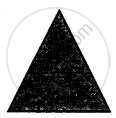Advertisements
Advertisements
प्रश्न
Verify Euler's formula for the following polyhedron:

उत्तर
In the following polyhedron:
Edges E=16
Faces F=9
Vertices V=9

Now, putting these values in Euler's formula:
LHS: F+V
= 9 + 9
= 18
RHS: E + 2
=16+2
=18
LHS = RHS
Hence, Euler's formula is satisfied.
APPEARS IN
संबंधित प्रश्न
What is the least number of planes that can enclose a solid? What is the name of the solid?
Dice are cubes where the sum of the numbers on the opposite faces is 7. Find the missing numbers a, b and c.

The figure, given below, shows shadows of some 3D object when seen under the lamp of an overhead projector:

A triangle
In this case, name the object.
Dice are cubes with dots or dots on the face. Opposite faces of a die always have a total of seven on them.
In the given below net to make dice (cube), the numbers inserted in the square indicate the number of dots in it.

Insert suitable numbers in the blank so that numbers in opposite faces of the die have a total of seven dots.
The following figure represent the nets of some solid. Name the solid

Using Euler’s formula, find the unknowns.
| Faces | Verticles | Edges |
| 20 | 10 | ? |
How many edges does the following solid have?
Kaleidoscope
Find the number of faces in the given shape:
The common portion of two adjacent faces of a cuboid is called ______.
A plane surface of a solid enclosed by edges is called ______.
